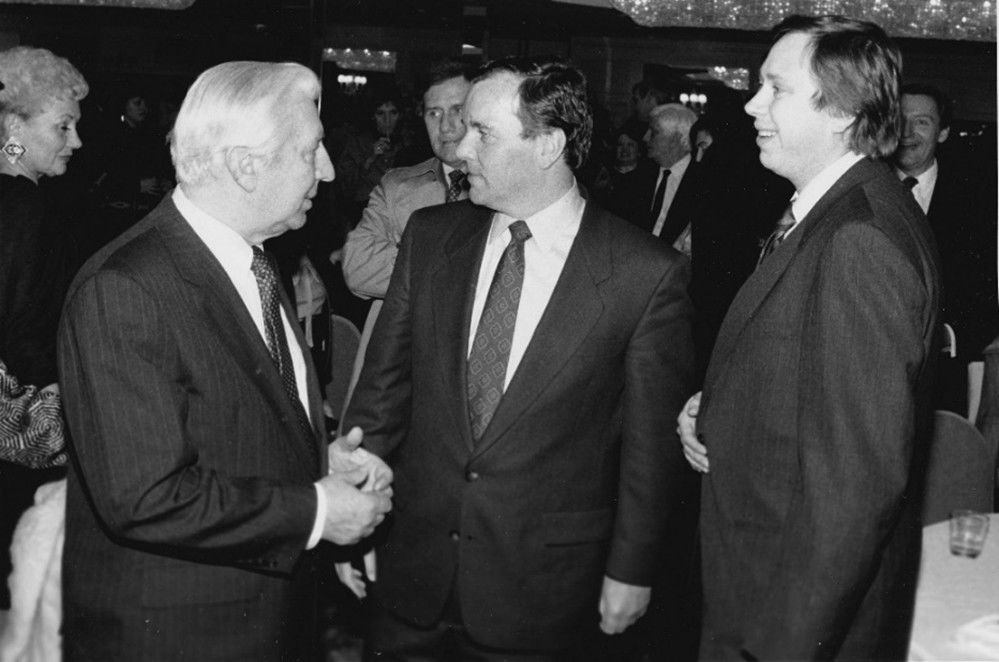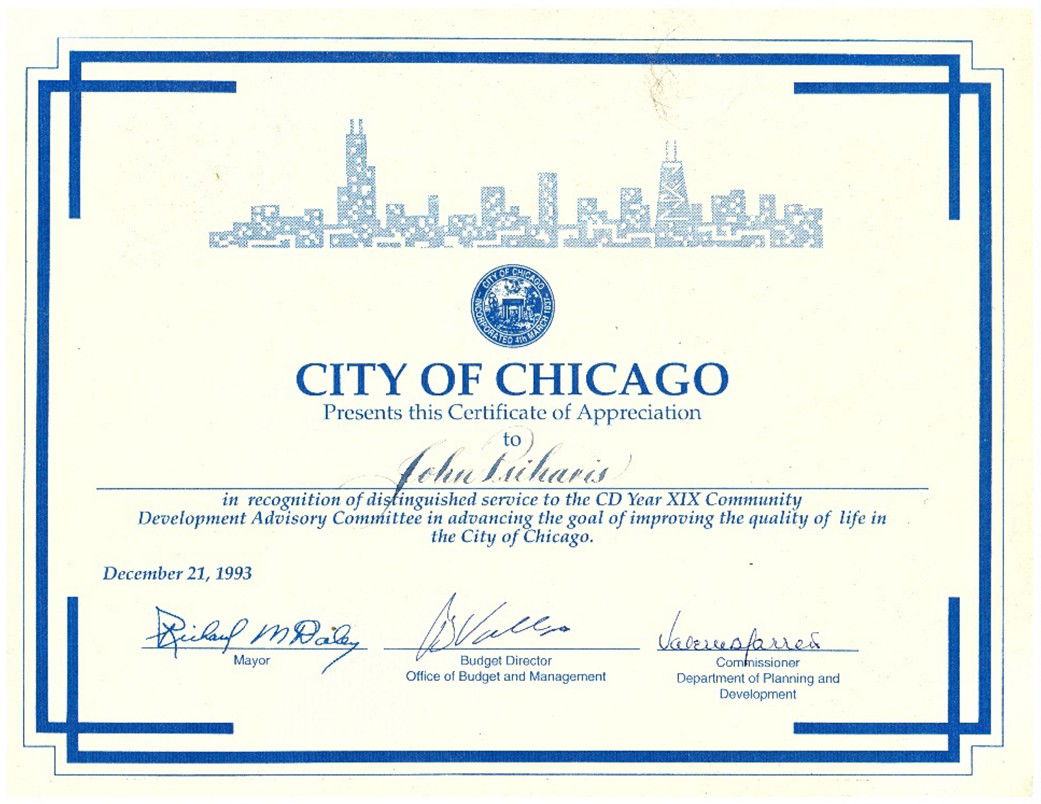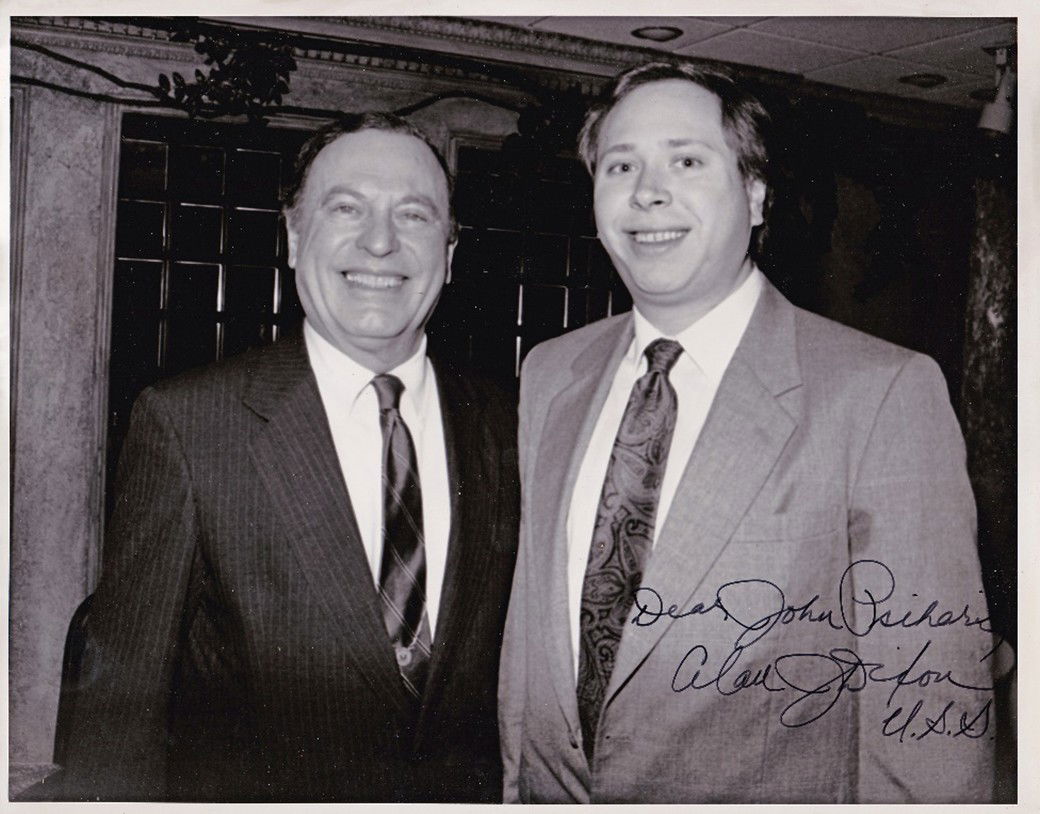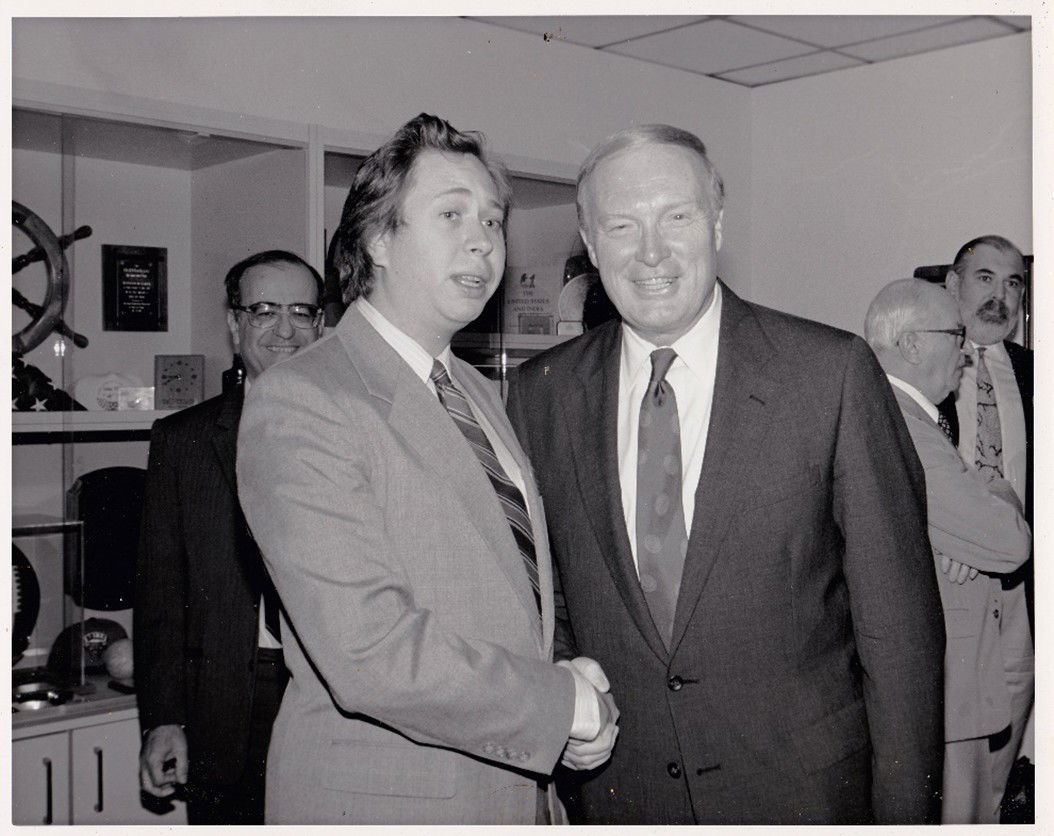Building Bridges into the Broader Community
From Working to Preserve Our Heritage: The Incredible Legacy of Greek-American Community Services
"Due in part to the success GACS achieved and the relationships we had built, Elaine and I were invited to take part on committees and boards within the broader community. In addition to our extensive involvement in the GANHC and CLESE, Elaine was on an advisory board for the Travelers and Immigrants Aid Society, a member of the Metropolitan Chicago Council on Aging’s Respite Care Committee and was active with the Illinois Ethnic Consultation. She was also active with the American Jewish Committee where she served as Chicago coordinator for a federal grant on caregiving and coordinated an ethnic women’s coalition. At times, I was on the advisory boards of Ravenswood Community Mental Health Center and Belmont Community Hospital.
In 1986, I was appointed by Mayor Harold Washington to serve as a member of the Community Development Advisory Committee (CDAC). This committee’s role was to monitor and advise the city about the allocation and use of Community Development Block Grant (CDBG) funds that were allocated to the city of Chicago. At the time this amounted to nearly $80 million per year. Two years later, I was reappointed by Mayor Eugene Sawyer and then twice by Mayor Richard M. Daley. I served on the CDAC for eight years.
CDBG funds were administered by the U.S. Department of Housing and Urban Development (HUD) and were allocated to cities based on the percentage of low and moderate-income populations they had within their municipalities. These funds were used for services and programs that benefited this population and were sometimes used to pay for city services for communities designated as low or moderate-income according to census tracts. There were about 30 members of the CDAC, and its membership consisted mainly of nonprofit and community leaders. The CDAC coordinator, Carolyn DeLoache, was based within the Chicago Department of Planning. Meetings were held on the third Tuesday of every month at 3:00 p.m. at City Hall. The subcommittees met monthly and sometimes more frequently during the annual grant review period.
Although advisory in nature, the committee was federally mandated to review and monitor CDBG-funded programs and approve the proposed budget. The decisions were non-binding but were submitted to the mayor and city council for review, reported to HUD, and placed in the public record. Each member served on a subcommittee that reviewed funding requests and priorities from their respective city departments and grantees under their purview and provided recommendations to department heads, the budget office, and the full CDAC. The subcommittees also monitored funded programs and heard reports from department heads.
For most of these years, I served on the Public Services Subcommittee. The committee oversaw the lion’s share of Chicago’s CDBG budget allocated to 14 city departments including Human Services, Aging, Disabilities, Employment and Training, Human Relations, Police, Fire, Streets and Sanitation, Libraries, Chicago Housing Authority, Board of Education, and Cultural Affairs (including the Mayor’s Office of Special Events). Most of the money was awarded in grants to hundreds of delegate agencies that provided services while the rest was used to subsidize services provided by the city. Other committees included the economic development and housing sub-committees. Given their more defined scope, these committees were able to be more hands-on by actually reviewing proposals submitted by applicants.
Due to the large and diverse portfolio of departments that reported to the committee, we primarily focused on overall budget numbers and priorities and did not usually review specific proposals from delegate agencies. Some departments, such as the Department of Human Services, had hundreds of delegate agencies receiving CDBG funding. Every August, the Public Service Committee set aside two eight-hour days (usually back-to-back) for department heads to meet with us. It took this long just to hear from each department about their priorities for the coming year and have some dialogue with them. It would take another full-day meeting for us to consider their proposals and prepare our recommendations to the full CDAC for ratification.
One program the committee nurtured was the First Aid Care Team (FACT) program, a partnership between the Chicago Fire Department, the Chicago Housing Authority (CHA), and the City Colleges of Chicago. The Hull House Association, as delegate agency for this program, coordinated advanced first aid training for CHA residents who were then employed to work at CHA buildings, city events, and neighborhood festivals. Opportunities to apply for paramedic training were also available.
I recall a hearing where we were grappling with federal budget cuts and had recommended reducing CDBG funding for a Mayor’s Office of Special Events program that provided free Jumping Jacks for block parties in low and moderate-income neighborhoods. The committee felt that CDBG funds could be better used to offset federal cuts to child and elder care services and that other sources of funds could be tapped for this recreational activity. For several days, I and others on the committee received a slew of phone calls from many who disagreed. It must have been a coordinated effort. Since our role was advisory, I do not remember the outcome and whether in the end the program was funded by CDBG or another source.
I was the first Greek American to serve on this committee. Dean Maragos was appointed several years later but he served on a different sub-committee. In addition to city department heads, the committee worked with Sharon Gist-Gilliam, the mayor’s budget director and city’s chief operating officer; Valerie Jarrett, Chicago’s director of planning and development, who later became a senior advisor to President Barack Obama; and Paul Vallas, who succeeded Sharon as budget director, and went on to a distinguished career in public service including chief of staff to the mayor and CEO of the Chicago Public Schools. Paul was a Democratic party candidate for governor of Illinois in 2002, narrowly losing to Rod Blagojevich. In 2015 he was an unsuccessful candidate for lieutenant governor in Governor Pat Quinn’s reelection campaign and went on to lead the New Orleans public school system during its rebuilding process after the devastation of Hurricane Katrina and was CEO of the School District of Philadelphia. Paul was a candidate for Chicago mayor in the 2019 municipal election, which Lori Lightfoot won. In February 2023, he was the top vote-getter in a field of nine candidates for mayor but lost to Brandon Johnson in the April runoff election.
Members of the CDAC had varied backgrounds and represented all parts of Chicago. Patrick Salmon, the chairman of the CDAC, who was appointed by the mayor, was the executive director of the Back of the Yards Neighborhood Council. David Truitt, an affordable housing advocate from Uptown, was co-chair. The chairman of the Public Service Subcommittee was Steven Bishop, vice president of government relations for the United Way of Metropolitan Chicago. Nancy Johnstone, executive director of Youth Guidance, served as co-chair. Committee members included: Freddy Calixto, executive director of Project BUILD; Michael Brickman who became deputy mayor for education under Mayor Daley; Darlena Wilkerson, administrator of the Donor’s Forum of Chicago Emergency Fund; Bill Fredrickson who represented the North Park Neighborhood Association; Arlene Knudson, Director of Pegasus Players; and Joann Merritt of the Hull House Association. Gertrude “Pudgie” Thompson from the Department of Human Services staffed the subcommittee.
On February 10, 11, and 12, 1989, during his reelection campaign, Mayor Sawyer invited me to join him and other ethnic leaders during “Unity Weekend,” a three-day citywide tour of several Chicago communities. We rode in “City One,” a converted CTA (Chicago Transit Authority) bus. The bus was sponsored by Citibank and used by the city to provide tours to business and governmental visitors. It had a bathroom, a television, and a mobile phone. There was carpeting and comfortable seating. Boxed lunches and ample beverages were provided.
On Saturday, the caravan visited events at Olive Harvey College, Operation P.U.S.H., the Rofei Zedek synagogue in Hyde Park, Temple Menorah, Illinois Institute of Technology, Grand Manor Banquet Hall (a Polish community banquet), St. James Church of God in Christ, American Indian Center, Ukrainian Cultural Center, and culminated with an Asian Lunar New Year’s celebration at Chicago O’Hare Holiday Inn Hotel. On Sunday, the delegation visited several churches including Iglesia Palestina, Mount Olivet Baptist Church, Cristo la Victoria, Iglesia de Dios, and Iglesia Asamblea Cristiana. The following Tuesday (February 14), the mayor hosted a reception for the delegation at the Holiday Inn Mart Plaza.
I recall it was snowing one of these days, and we had fallen behind schedule due to bad traffic. Although we had a police escort, it didn’t help much when the weather was bad. At one point the bus briefly got stuck in the snow. It was quite an experience being with the mayor for a weekend and visiting events throughout the city that I would have never experienced otherwise.
I remember a stop at Operation Push in the Kenwood neighborhood. A standing-room-only crowd greeted us as we entered the room, and the Reverend Jesse Jackson gave an impassioned speech in support of Mayor Sawyer, ordering that the doors remain closed until each person in the room made a donation. He began the bidding at $1,000 and worked his way down. I don’t recollect how much was raised, but a good amount of money was raised through this aggressive yet effective fundraising technique.
I was appointed by Lois Weisberg, commissioner of the Chicago Department of Cultural Affairs, to serve as chairman of the City Arts Grants Social Services subcommittee for a three-year term. This committee reviewed requests for City Arts grants that came from social service agencies (as opposed to arts organizations) and made funding recommendations to the Department. Mary E Young served as the director of cultural grants, Johnathon Stillwell was the City Arts grants director and Juana Guzman was the Neighborhood Arts Program coordinator. They provided staff support to the committee and sat through our meetings.
In the days before the Internet and online applications, serving on a grant review committee was a labor-intensive experience. We received paper copies of each grant submission delivered to us in a large box by courier. The committee reviewed about 100 applications and each application consisted of several pages of narratives, budgets, and an array of attachments that could make each application up to 50 pages or longer. Some requests were slick and professionally prepared while others were handwritten. I kept the box in my office and grabbed a handful of applications every day to review and score. Sometimes, I would take a few proposals with me and go to Little Mike’s for coffee to read them because the office was hectic and noisy when ADC clients were participating in various activities. Funded projects included an array of arts programming for children, seniors, ethnic communities, and others. A few that I remember included art classes for children of domestic violence victims, origami classes for Japanese children, cultural programming for refugee children, community murals, dance classes for seniors, service-learning projects, and arts programming targeted toward crime and gang reduction efforts.
Each year, the committee met for three full days in early November to review and score the submitted proposals. A continental breakfast, lunch, and refreshments were provided so that we didn’t need to break. Committee members were each tasked with presenting an equal number of proposals to the group. As chairman, I did not present any requests but instead guided the discussion and decision-making process for each proposal. After each grant was presented, panelist scores were tabulated, and a vote was taken on whether or not to fund the program. Allocation amounts, based on the total funding available, were finalized by DCA. Since GACS was an annual recipient of this grant, I abstained from GACS-related discussions and left the room when our proposal was under review.
As committee members, the grantees invited us to their events and performances. Throughout the year, as time allowed, we attended as many as we could. It was an enlightening experience to visit all parts of the city and observe the impact of the funding we provided. I remember attending the opening of a play written and performed by at-risk youth at the Better Boys Foundation, classes on origami at the Japanese American Service Committee, art classes for refugee children at a resettlement agency, and events at the American Indian Center, Erie Neighborhood House, and Gads Hill Community Center.
At various times, I was invited to attend meetings or serve on committees involving the Greek community, adult day care or ethnic elderly matters, and other areas of concern. I recall participating in a task force established by Senator Alan Dixon, an ethnic advisory committee for Illinois Attorney General Neil Hartigan, and participating in a two-day focus group on multicultural and ethnic issues facilitated by the Chicago Community Trust. I was an escort for Senator Paul Simon as he visited Greek restaurants and businesses in Lincoln Square and served on the Greeks for Carol Moseley Braun for the U.S. Senate Committee."

Chicago Mayor Eugene Sawyer and John Psiharis. February 1989. John Psiharis collection.

(L-R): Alderman Roman Pucinski, Mayor Richard M. Daley, and John Psiharis during a CDAC Holiday Reception hosted by the mayor. I was discussing the nursing home project with the mayor, and he invited the alderman to join the conversation when this picture was taken. Date unknown. John Psiharis collection.

Community Development Advisory Committee Certificate of Appreciation signed by Mayor Richard M. Daley, Paul Vallas, and Valerie Jarrett. December 21, 1993. John Psiharis collection.

U.S. Senator Alan Dixon and John Psiharis. Date unknown. John Psiharis collection.

John Psiharis and Illinois Attorney General Neil Hartigan. Background: John Rassogianis, Jim Mezilson, and unknown. Date unknown. John Psiharis collection.